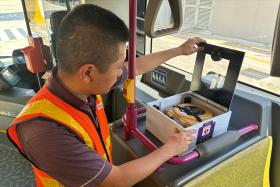Grab's success lies in its user-centric platform in South-east Asia
Rise of the ride-sharing company lies in its user-centric platform
The world's largest carmaker, Toyota, will invest US$1 billion (S$1.35 billion) in South-east Asian ride-sharing app Grab.
This will be the second major move for Toyota, after forming a strategic alliance in 2016 with Uber, where they decided to co-develop autonomous driving technology.
The rise of Grab, culminating in this latest investment by Toyota, has been exceptional. It is exceptional because Grab, which first launched its service with 40 drivers in Kuala Lumpur in 2012, was late to the ride-sharing game, coming only after Uber had already established a formidable position in the US.
Grab has since toppled Uber in South-east Asia in March this year, when Uber sold out its operations in Cambodia, Indonesia, Malaysia, Myanmar, the Philippines, Singapore, Thailand and Vietnam.
No business model is more attractive than a platform, which is essentially a marketplace that enables the exchange of goods or services on the supply side and purchases on the demand side.
A platform is also the business model that Uber, Airbnb and Alibaba have adopted.
Among economists and academics, the "network effect" has been a common refrain used to explain the spectacular growth of these businesses.
They argue that the value of a platform depends, in large part, on the number of users on either side of the exchange. That is, the more that people use a platform, the more inherently attractive it becomes, leading even more people to use it.
That is why Facebook is obsessed with growth in the US and internationally, even in the developing world.
That is also why, when Snapchat went public in March last year, the number of daily active users became the single most important metric for potential investors.
The more that people hang out on Facebook or Snapchat - reading news and playing games - the more willing big brands will be to buy ads on them.
Only when a platform reaches a certain size does it become too dominant to unseat, or so the theory goes.
However, Grab's unlikely rise against Uber illustrates that size is more a consequence than the direct source of greatness.
What works well in one country may fare badly in another. Any platform needs to achieve a product/market fit to succeed in the long run.
Mr Anthony Tan, co-founder and chief executive of Grab, saw that it was imperative to understand and build regional distinctions into a product.
In the Philippines, where eight major dialects are spoken, a representative will speak in the local dialect when someone calls Grab's customer service.
Passengers can also text drivers via a chat feature with automated translation.
Instead of forcing drivers to accept credit card payments in the name of "frictionless" transactions, Grab embraces cash.
"We understood the taxi driver's need for daily income. We understood that a lot of people really use cash. We respect the hyper-local culture in places we operate," Mr Tan said.
In Singapore, Grab lets users input numeric codes for nearby taxi stands in lieu of addresses.
The latest investment in Grab by Toyota is therefore a validation of a new playbook of our Internet economy.
Transportation has never been, and never will be, composed of purely digital "bits".
When a platform strategy requires a mixing of digital and physical, the key area of differentiation remains how the service is delivered in the physical world.
The writer is the author of Leap: How To Thrive In A World Where Everything Can Be Copied , LEGO professor of management and innovation at the IMD Business School in Switzerland, and director of IMD's signature Advanced Management Program. This article appeared in The Business Times yesterday.
Get The New Paper on your phone with the free TNP app. Download from the Apple App Store or Google Play Store now

